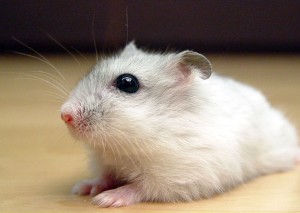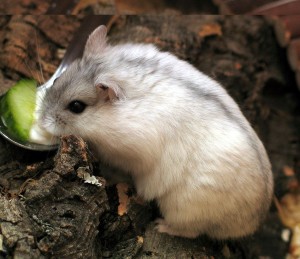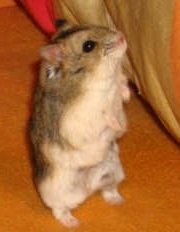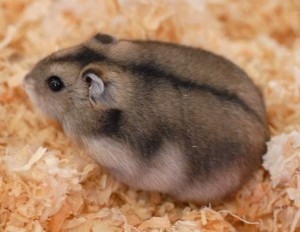Russian Dwarf Hamster refers to two species of hamster. The Winter White and the Campbell’s Dwarf Hamster. These two appear similar to each other and are often confused. Breeders all over the world have bred many different attractively colored hamsters. These are called ‘fancy hamster.’ Most “Russian Dwarf” Hamsters available to buy from pet shops are Hybrid Dwarf Hamsters.
Winter White Dwarf Hamster Facts
Winter Whites are also known as the Siberian Hamster or the Djungarian hamster. The Winter White can be found in Siberia and Central Asia. Their average lifespan is one to three years. In the wild they generally live much shorter lives. These hamsters have the ability to change color from dark grey to white during winter time in the wild, hence the name – Winter White. In the domestic environment, they don’t turn white because of the artificial conditions of light and heating in the house.
Typically the Winter White is dark grey with a dorsal stripe along the spine, there are some other variations including;

- Marbled
- Sapphire Pearl
- Sapphire
- Pearl
Winter White Dwarf Hamster Gestation
Winter whites have a gestation period of 18 – 25 days and can start breeding after 4 – 6 months. They typically have 4 to 8 pups; there have been recorded instances of as many of 14 pups in a litter.

Winter White Russian Dwarf Hamster
Campbell’s Russian Dwarf Hamster

Campbell’s Dwarf Hamsters are very similar in appearance to the Winter White, and they are the most Dwarf Hamsters found in pet shops. They are distinguishable from the Winter White by its smaller ears and, in particular coloration – lack of dark patch on the crown of the head.
Campbells do not turn white in the winter, and they are less tolerant to cold weather. Campbells react to cold temperatures by exercising and sheltering, as opposed to curling up like the Winter White. In the wild, they can be found in China, Russia, and Central Asia. They typically live from 2 to 2.5 years as domestic pets. They live shorter lives in the wild.
Campbell’s Dwarf Hamster Breeding
Campbell’s have a gestation period of 18 – 20 days and can start breeding after 3 – 4 months. They typically have 4 to 8 pups, there have been recorded instances of as many of 14 pups in a litter.

Campbells Dwarf Hamster
